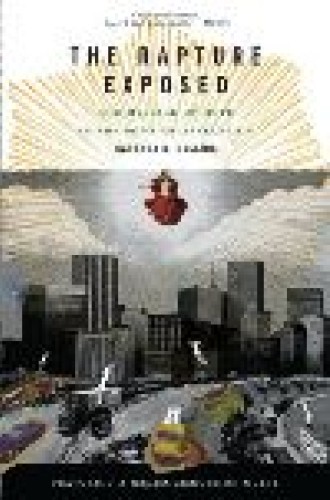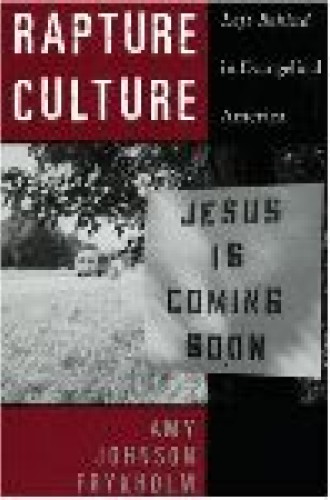En-raptured
"I heard that when the tribulation comes, China will be one of the few countries with a big enough army to take over the United States.” My parishioner looked at me earnestly, awaiting confirmation of her theological and political observation. This woman, the spiritual rock of the church, doesn’t fit the media profile of those who believe in the “rapture.” She is well educated, deeply involved in the community and a successful businesswoman and civic leader—hardly a Neanderthal or escapist.
I decided to respond with what I took to be a fairly plain-vanilla, noncontroversial geopolitical observation: “Actually, North Korea’s army is bigger than China’s.” She nodded, satisfied, and headed off to her third church meeting of the week.
What a failure on my part. But I wasn’t equipped to respond adequately. I had seen the glossy displays of the Left Behind series in bookstores, had heard claims that the novels (the 12th and final installment is due out this spring) had sold more than 60 million copies, but had never met anyone who actually believed in the rapture, neither in my college evangelical fellowship groups nor in seminary. Then I received my first rural church assignment and quickly discovered that out here I was the only person who didn’t believe in the rapture. My parishioners simply assume that this is what the Bible teaches. And why shouldn’t they—they’ve never heard otherwise from their preachers.
That I didn’t even know enough about dispensationalism to disagree with it intelligently is no accident. Mainline seminaries have ignored this phenomenon in inverse proportion to its growing social and political influence. Meanwhile, the rapture’s proponents have not only established a publishing juggernaut; they have also been influencing members of Congress and presidents.
This is deeply ironic. For generations mainline Protestants have tried to “demythologize” the contents of scriptures and creeds in an effort to gain social and political influence, while dispensationalists have avidly “mythologized” the Bible into ever more incredible systems of belief about the “end times.” Mainline churches’ influence has sagged as we have carried out this bargain, while the dispensationalists’ has grown immensely. The rising tide of end-times fiction and politics urges us to take a long, hard look in the mirror.
For befuddled pastors, help is on the way. Two new and quite different books offer a glimpse into the thought world of those who believe in the rapture. Amy Johnson Frykholm analyses the literature from a broad range of perspectives—literary, critical, historical, sociological, feminist and theological. (The theological focus is impressive in a scholar who professes to be a recovering former fundamentalist and mostly nonreligious.) While Frykholm has no sympathy with the Left Behind series theologically, politically or literarily, she has a great deal of sympathy with its readers and she explores why people with interesting lives are drawn to such schlock in their religious reading. Her book is a good place to start if you’re wondering what these novels are about and why they appeal to people.
Barbara R. Rossing’s book is more polemical. Anger drives this Lutheran minister and seminary professor. She hates what Left Behind has done to popular Christian eschatology, to the Bible, to public policy and especially to Christians’ attitudes toward the environment. (Why save trees when the world is soon going to burn up anyway?) She seeks to rebut the dispensationalists’ views and offer a more deeply biblical vision of Jesus’ eschatological kingdom.
The basic storyline of premillennial dispensationalism—the system of thought that informs “rapture fiction”—originated in the mid-19th century in the teachings of John Nelson Darby, a disaffected former Anglican priest. This version of eschatology holds that the Bible, read aright, contains a schedule for the final events that will precede the end of history. Darby believed that God deals with the world differently in each of seven “dispensations,” or eras. We are now in the sixth era of world history, soon to be followed by the seventh—the end times.
The first event in the chain of dominoes that will lead to the end is the “rapture”—the secret return of Jesus to transport all true believers (i.e., not mainline liberal Protestants) to heaven. Cars, trains and planes will fly into one another as believers are suddenly taken heavenward, leaving their clothes, personal effects and vehicles behind (hence the bumper sticker: “Warning: in case of rapture this vehicle will be unmanned”). Those “left behind” will endure seven years of tribulation, mostly inflicted on the world by the Antichrist, disguised as the leader of a one-world government (read: the United Nations). Some of those shocked by the sudden disappearance of their loved ones will become true “Bible-believing” Christians who will band together to resist the wiles of the Antichrist and conduct secret evangelism campaigns meant to grow the power and numbers of their “tribulation force.”
The plot of the Left Behind novels follows several characters who make up the heart of this force: Rayford Steele, an airline pilot; Buck Williams, a journalist; and their enemy, Nicolae Carpathia, the Antichrist. The heroes are quite busy. According to the “biblical prophecies” on which the novels are based, the Antichrist will support a Russian invasion of Israel, rebuild the Jerusalem temple, and lead nation into war against nation. This global warfare, coupled with a series of horrible natural disasters, will make the world a truly nasty place.
Finally, after seven years of death-dealing by the Antichrist and growing resistance by the tribulation force, Christ will return a second time to defeat the forces of evil at Armageddon, a large plain in Israel. He will then reign, before the world finally ends, for 1,000 years, over a politically reconstituted kingdom of Israel, full of Jews who have converted to Christianity.
This system is subject to endless variations. For example, the enemies can change. In Hal Lindsey’s 1970s rapture fiction, all the bad guys are Soviets. The villains can also morph into Muslims, as they often have in the post-9/11 world.
Frykholm’s book helpfully situates the Left Behind series in relationship to previous generations of rapture fiction, which stretch back to the early 20th century. These books have traditionally begun with the rapture of a significant woman character. In Left Behind, the first book of the series, Steele’s wife, Irene, leaves only her nightgown and her open Bible behind in a rapture that occurs while he is away on the job, flirting with another woman. Faithful, long-suffering women should be extolled for their virtue but should not expect any this-worldly justice, the books imply. In this regard, the Left Behind series is no different from its many predecessors.
Historians note that dispensationalism and its fiction arose just as American culture was undergoing seismic social shifts in the late 19th and early 20th centuries. It offered reassurance that conservative social values some day would be vindicated. The Left Behind series stands in a long line of books reacting against change—not only against independent and strong women, but also now against gays and lesbians.
Yet the series leaves its predecessors far behind in its embrace of technology. Steele and Williams use ultra-high-tech computers, satellite phones, the Internet, covert underground bunkers, superfuturistic weapons and massive range rovers driven in ways that conflict with local traffic laws. They rely on their elite educations, political connections at the highest levels and limitless reserves of cash.
In other words, this is not your grandma’s Scofield Bible–inspired tribulation force. The first line of the first book makes that clear: “Rayford Steele’s mind was on a woman he had never touched. With his fully loaded 747 on autopilot above the Atlantic en route to a 6 a.m. landing at Heathrow, Rayford had pushed from his mind thoughts of his family.” Frykholm calls this description “an image not so subtly connected with sexuality and worldly power.” The series’ combination of social reactionism, an embrace of technology and an engagement with a prognosticated global geopolitical clash is a heady cocktail, and the source of the books’ widespread appeal.
Frykholm suggests that dispensationalist categories have so affected not only evangelical and fundamentalist believers but also nonbelievers, mainline believers and politicians that they have blurred the distinction between “mainline” and “fringe,” “religious” and “political.” Yet the books retain the rhetoric of presumed social isolation. Their authors, Tim LaHaye and Jerry B. Jenkins, and their adherents expect to be criticized or snubbed by mainline ecclesial institutions and academic elites. Critiques like this one will undoubtedly serve to fortify their view of themselves and the world.
Frykholm also offers the beginnings of a theological critique. She notes how the books assume that the mass global conversions expected to take place during the tribulation will be of the Protestant fundamentalist sort, engineered by giant “Promise Keeper–like rallies in sports stadiums” that, the authors presume, “the entire world finds as captivating as Americans do.” All of the books’ Christian characters, “whether they are Middle Eastern, Greek, or from the American Midwest, speak in the idiom of American evangelicalism,” a sort of “protestantese.”
Frykholm asks what, precisely, these people mean by conversion, by the “accepting” of Christ at altar calls. She suggests it reflects a willingness to take on the worldview and speech of evangelicals. She wonders about Tyndale Press’s claim that millions of people have been converted through these books. In conducting dozens of interviews, she has failed to find a single convert who traces her or his conversion to the books. When she asked the publisher for proof of its claim, she received copies of seven letters by writers who said they knew of someone else converted through reading. Frykholm concludes that the books are captivating only to those who already share their theological worldview, and are often repulsive to those who do not.
Frykholm’s criticism of the novels is balanced by a positive portrait of the Left Behind readers. Though some might view these readers as mindless droids in a pro-apocalypse army, they actually are diverse and thoughtful people. They argue with the books, they read them for reasons at cross-purposes to those for which they were written, and they put them to interesting uses. Readers insist that the books are appealing because they make the difficult and disparate writings of scripture “come to life.” Rapture fiction also connects the dots between chaotic and frightening world events, and it points toward an ultimate coherence in things.
The idea of a secret band fighting an underground war for good appeals not only to our apocalyptic instincts—as demonstrated by the popularity of Star Wars and The Lord of the Rings—but also suggests a more exciting life than most of us lead, a life full of mystery, intrigue and moral certainty. The description of believers who physically vanish and who, left behind, receive a special mark identifying their allegiance to good, suggests that the now invisible divide between the righteous and the wicked will be revealed. Finally, these books create community. The volumes are read, discussed, lent and borrowed.
Rossing issues a salvo with her opening line: “The rapture is a racket.” Her first paragraph is a full-blown jeremiad: “In place of healing, the rapture proclaims escape. In place of Jesus’ blessing of peacemakers, the rapture voyeuristically glorifies violence and war. In place of Revelation’s vision of the Lamb’s vulnerable self-giving love, the rapture celebrates the lion-like wrath of the Lamb. This theology is not biblical.”
The rest of her short book is devoted to demolishing the dispensationalists’ reading of the Bible, and to offering a counterstory of the incarnate love of God that refuses to leave his church or his world behind. Rossing describes her opponents’ view with a twist on John 3:16: “God so loved the world that he gave it World War III.” Not that the true believers will be around for all the bloodshed. Those raptured away will watch the desolation of the earth from a front-row seat in heaven, enjoying the tribulation poured out on those left behind, says proponent John Hagee.
Rossing sees all this as a frighteningly stark contrast to the actual message of the Bible, in which God comes to be incarnate in God’s world and promises not to leave God’s church. She speaks of the message of the gospel as a sort of “rapture in reverse,” in which God refuses distance and comes to be present, as opposed to a world left bereft of God and church, abandoned to punishment.
Unlike Frykholm, Rossing makes no attempt to find sympathetic points of contact with the fiction or its readers. She has no problem imputing malicious motives to the Left Behind writers: “Slaughter sells books.” Most compellingly, she presents a frightening list of political statements by powerful people, demonstrating that their belief in the rapture leads them to support ugly public policies. Dick Armey, the retired House majority leader, promoted the removal of all Palestinians from their ancestral land to an unpopulated desert. Ronald Reagan’s secretary of the interior, James Watt, discouraged pro-environmental legislation because of what he saw as the likelihood of the Lord’s imminent return. Conservative pundit Anne Coulter recently paraphrased God’s giving over of creation to human sovereignty by saying, “God said, ‘Earth is yours. Take it. Rape it. It’s yours.’” Oklahoma Senator James Inhofe supported the expansion of Israeli settlements in the West Bank by citing Genesis and calling the debate on the issue “not a political battle at all. It is a contest over whether or not the word of God is true.”
Finally, Rossing cites a number of religious broadcasters who insist on the impossibility of avoiding Armageddon. The end is near. Resistance is futile. Why should anyone support peace in the Middle East, or anywhere else? Or environmental conservation? Rossing accuses the rapture’s supporters of a kind of “sickness,” a Caligula-like lust for war that rivals anything promoted by the imperial cult of Rome. “It’s blood,” notes Steele of the red-stained snow and burning hail falling all around him in Soul Harvest (number four in the Left Behind series), “and a sense of peace flooded his soul.”
Rossing also dissects dispensationalists’ reading of scripture and advocates a more faithful eschatology. She describes the dispensationalist interpretation of Daniel 9’s “70 weeks of years” as a schedule for the end that was interrupted by the Jews’ refusal of Jesus as king. The “prophetic stopwatch” is now stuck at 69. The final week of years—the tribulation—will come when the rapture begins. Simply laying out these sorts of arguments has the effect of making their facile nature plain. An appendix to the book gives a detailed critique of the dispensationalist reading of crucial biblical passages.
Rossing praises Martin Luther’s comment that if he knew the world was to end tomorrow, he would plant a tree. True eschatological insight ought to press Christians into deeper, more loving, even more mundane dealings with God’s world, she argues. Rossing attempts to present a counterstory about God and his world to that told by dispensationalists, one that focuses on “Lamb power” rather than phantasmagoric fantasy, one marked by Jesus’ eschatological proclamation of a kingdom of nonviolence, charity and peace.
The strength of both books lies in their authors’ lively engagement with the subject. Both Frykholm and Rossing raise a key question: To what degree can we call dispensationalism “heresy”? Frykholm suggests parallels to gnosticism, Rossing to the Manichees. Do mainline Protestants even have heresy any more? What would such a pronouncement from ecclesial bodies accomplish? It might just reinforce the dispensationalists’ rhetoric and view of themselves as culturally isolated, even as they sell millions of books and elect powerful legislators.
Or it might force mainline pastors like me patiently to explain precisely why this view of the world conflicts with scripture and orthodox teaching in ways that lead to contorted lives and twisted church practice. It might lead us to offer a contrasting vision of a politics informed by a slain lamb whom we claim rules the cosmos, whose rule encourages us to participate in God’s peacemaking between Americans and Chinese or North Koreans, between Israelis and Palestinians, between pastors and parishioners, between liberals and conservatives, between humanity and the rest of God’s creation.







